I observed at Lewis Young Park in Louisburg, Kansas Tuesday evening, June 13, 2023 with ASKC friend Bill Barlow, who motivated me to get to a darker site for the first time in months. I had qualms about the sky conditions, but Bill (a retired meteorologist) said it was our best shot the whole week for decent observing conditions. And the sky was clear overhead and to the south, exactly as he predicted. Thank you, Bill! The above image of M 44, the Beehive Cluster in Cancer, is from WIkimedia Commons and was made by Giuseppe Donatiello.
Tuesday evening happened to be the closest approach of Venus to the Beehive cluster, so needless to say that was on our observing agenda.

Shown above as an Oberwerk 120XL-SD binocular telescope with Morpheus 12.5mm eyepieces (53.60x / 1.46 degree FOV) pointed at Venus which can be seen in the twilight sky. The 120XL provided fine views of the conjunction, as did the Nikon 10×50 WX on a Farpoint p-gram. What probably would have been ideal is the 70XL-ED with Explore Scientific 24mm 68 degree eyepieces (16.25x / 4.18 degree FOV), but alas I was traveling light (fewer than 10 binoculars) and the 70XL was languishing at home. Darn it!
I also planned to have a go at supernova SN 2023ixf, which burst onto the celestial scene (literally) in mid May, discovered on May 19 by amateur astronomer Koichi Itagaki, a prolific supernova hunter who lives in Yamagata City, Japan. My expectations were not high, but the supernova was easily seen with the 120XL.

It formed a triangle with the 8th and 9th magnitude stars HD 122865 and HD 122601. M101 itself was readily seen in the field with a distinct core and a fainter envelope with the vaguest hint of spiral arms. Nothing like the image shown in Sky Safari, of course. ![]()
And the image is misleading because the star annotated as 12.44 magnitude (TYC 3852-1069-1) is more than a magnitude brighter than nearby GAIA 1609250720267947264 (magnitude 13.51) which looks brighter in the image, presumably due to whatever wavelength the camera was more sensitive to than visual. I saw no hint of it last night. The faintest star I identified was GAIA 1609231272656066816, magnitude 12.90. The transparency last night was rather indifferent, with Canada forest fire smoke still present in the atmosphere. On a better night the 120XL would reach stars in the 13th magnitude range, possibly fainter than 13.5 with the Pentax 10mm XWs (67x).
It was a fun and exciting thing to see, and the observation played to the 120XL’s strengths — deep starfield reach and easy star hopping thanks to binocular vision and the correct image. It took only minutes to identify the supernova referencing Sky Safari. A “new” 11th magnitude star not shown in the chart. A nearby 11.48 magnitude star (TYC 3852-1108-1) provided a handy reference, confirming that the supernova (which was brighter) is still close to 11.1 magnitude.
Another item on my observing agenda was the galaxy NGC 3184 near the double star SHY 552 in Leo Minor, which appears in a simbad image included in a recent post about observing SHY 552. The galaxy itself is over the border in Ursa Major. The galaxy could be held steadily in averted vision with the 120XL and Morpheus 12.5mm eyepieces. Seen as a faint, round nebulosity. The faintest star I could see in the field was TYC 3004-0110-1, 11.72 magnitude.

